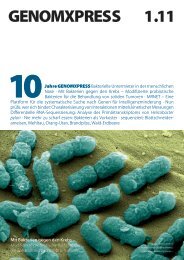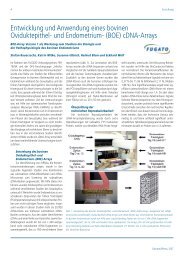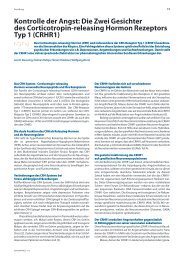Download GENOMXPRESS 4/2002
Download GENOMXPRESS 4/2002
Download GENOMXPRESS 4/2002
Sie wollen auch ein ePaper? Erhöhen Sie die Reichweite Ihrer Titel.
YUMPU macht aus Druck-PDFs automatisch weboptimierte ePaper, die Google liebt.
13 Gastautor<br />
GÉNOPLANTE 1 , THE FRENCH NATIONAL<br />
NETWORK IN PLANT GENOMICS.<br />
Its scientific aims with special regards to the creation of the European Research Area<br />
Dominique Job 2 · Scientific coordinator of the Génoplante programs<br />
Summary: Supported by the Ministry for Research and the Ministry for Agriculture since its inspection on February<br />
23rd, 1999 Génoplante is asserting itself as one of the top plant genome programs in the world. Bridging together<br />
the best public and private research laboratories in the seed and agrochemical sectors in France, Génoplante<br />
represents an essential framework for the study of plant genomes from model species to species of agronomical<br />
interest. This model of national cooperation constitutes one of the driving forces behind the construction of a<br />
dynamic pan-European collaboration in a strongly competitive international context.<br />
Ambitions of plant genomics<br />
The spectacular advances made in molecular<br />
biology, bioinformatics and various other<br />
technologies such as high-throughput sequencing<br />
and transcript imaging have opened a new global<br />
field for the investigation of living matter, i.e.,<br />
genomics. It includes drawing up a list of genes<br />
that constitute an organism and subsequently<br />
understanding their regulation, functions and<br />
interactions. In its basic understanding, this new<br />
science aims at cataloguing gene expression by<br />
mRNA profiling either by DNA chips technology 3,4 ,<br />
or by Serial Analysis of Gene Expression 5 (SAGE).<br />
However, since it is now generally recognized that<br />
a major part of gene expression in eucaryotes not<br />
only occurs at the transcriptional level, but also at<br />
the post-transcriptional and post-translational<br />
levels (alternative splicing, post-translational<br />
modifications), the same type of global approaches<br />
is currently being thoroughly extended to the<br />
major class of gene products, i.e. the proteins that<br />
perform the cellular functions (proteomics) 6 and<br />
the various metabolites produced by complex<br />
metabolic pathways that provide the substrates<br />
for general metabolism, the signaling molecules<br />
for transduction processes and the building blocks<br />
for macromolecular biosyntheses (metabolome<br />
analyses) 7 .<br />
For the last recent years, large-scale international<br />
efforts have been mobilized in applying genomics,<br />
proteomics and metabolomics to plants. Génoplante,<br />
the French national program on plant<br />
genomics, is, with its companions GABI 8 and<br />
GARNet 9 , an example of the European initiatives<br />
in this field.<br />
Despite the successful sequencing of the genome<br />
of the model plants Arabidopsis 10 and rice 11 , the<br />
function of many of the genes present in plants<br />
remains to be established (out of about 30,000<br />
genes encoded by the Arabidopsis genome, as<br />
much as a proportion of 45% have no obvious<br />
function).These functions cannot simply be deduced<br />
from comparative genomics with other<br />
eucaryotes as mammals. An obvious explanation<br />
is that plants cannot move and therefore have<br />
developed complex and specific defense mechanisms<br />
to cope with environmental constraints:<br />
exposure to extreme temperatures, light conditions<br />
and pathogens or water and nutrients availability.<br />
It is the challenge of plant genomics to unravel the<br />
role of these genes and to understand how they<br />
interact in controlling plant development and<br />
yield or the response of plants to biotic and abiotic<br />
stresses. In particular, a major challenge is the<br />
production of crops in an environmentally sustainable<br />
manner. Yearly, billions are spent on the protection<br />
of our crops. Yet, this protection often has<br />
a negative impact on our health and our environment.<br />
Apart from these important agronomical<br />
applications, it is also expected that many of these<br />
plant genes will turn out to be important for animal<br />
and human health, including nutritional quality<br />
(e.g. protein, lipid, carbohydrate, vitamin contents)<br />
12 and protection against human disease 13 .<br />
For example, in the light of understanding cellular<br />
aging 14 , which is a major concern in human<br />
health, much is to learn on the mechanisms involved<br />
in the long-term survival of mature dry seeds<br />
and the account for their exceptional storability 15 .<br />
Plants are also unique amongst eucaryotes in<br />
their wealth of metabolic activity. As a defense<br />
against biotic and abiotic stresses, they are able<br />
to synthesize a multitude of chemical compounds.<br />
These provide an invaluable source of potential<br />
pharmaceuticals, health-promotors, flavor and<br />
fragrance compounds, protectants, biocides, fine<br />
chemicals, etc. Most plant metabolites remain to<br />
be characterized, and their biological roles and<br />
potential pharmaceutical and nutritional applications<br />
are very poorly understood. The rapid progress<br />
of plant genomics, proteomics and metabolomics,<br />
notably in Europe, can provide answers to<br />
these important questions. But the task is immense<br />
and necessitates a combination of various<br />
efforts.<br />
Génoplante.<br />
Aims and Organization<br />
In the face of difficulties linked to the high<br />
level of technology in the tools and the difficulty<br />
of integrating the data obtained from model species,<br />
genomics requires the association of several<br />
multidisciplinary and complementary human<br />
skills. Indeed, such large scale technologies and<br />
computer tools cannot be set up in isolated laboratories<br />
as they require considerable human and<br />
financial resources. One these grounds, Génoplante,<br />
a five-year program in plant genomics,<br />
represents a model for cooperation between research<br />
in both the public and private sectors at the<br />
national level. Main strategic goals are to strengthen<br />
plant genomics in France, to create technological<br />
platforms widely open to the whole scientific<br />
community, to protect research results, and to<br />
support international collaboration.<br />
Organization<br />
Génoplante involves public (INRA, CNRS,<br />
CIRAD, IRD) and private partners [Biogemma, Bio-
















